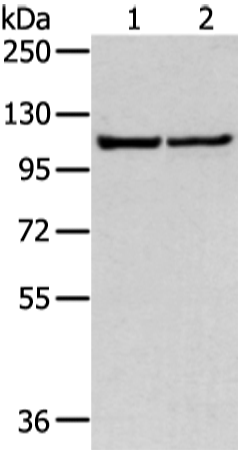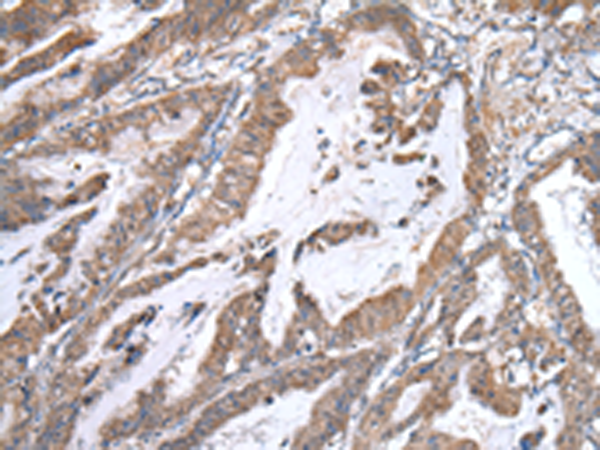

| WB | 1/500-1/2000 | Human,Mouse,Rat |
| IF | 咨询技术 | Human,Mouse,Rat |
| IHC | 1/30-1/150 | Human,Mouse,Rat |
| ICC | 技术咨询 | Human,Mouse,Rat |
| FCM | 咨询技术 | Human,Mouse,Rat |
| Elisa | 1/2000-1/5000 | Human,Mouse,Rat |
| Aliases | AIP5; Tiul1; hSDRP1 |
| WB Predicted band size | 105 kDa |
| Host/Isotype | Rabbit IgG |
| Antibody Type | Primary antibody |
| Storage | Store at 4°C short term. Aliquot and store at -20°C long term. Avoid freeze/thaw cycles. |
| Species Reactivity | Human, Mouse |
| Immunogen | Fusion protein of human WWP1 |
| Formulation | Purified antibody in PBS with 0.05% sodium azide and 50% glycerol. |
+ +
以下是3篇与WWP1抗体相关的参考文献概览:
---
1. **"WWP1-mediated PTEN ubiquitination regulates its nuclear localization and tumor suppressor function"**
- **作者**: Lee et al. (2020)
- **摘要**: 研究揭示了WWP1通过泛素化修饰PTEN蛋白调控其核内定位,促进前列腺癌进展。实验中利用WWP1特异性抗体进行免疫共沉淀(Co-IP)和Western blot分析,证实WWP1与PTEN的相互作用及功能关联。
2. **"Structural basis for the ubiquitin ligase activity of the WWP1 HECT domain"**
- **作者**: Zhang et al. (2018)
- **摘要**: 通过冷冻电镜解析WWP1的HECT结构域与其底物结合的分子机制。研究使用WWP1抗体进行蛋白质纯化验证,阐明其催化泛素转移的关键结构域,为靶向WWP1的药物设计提供依据。
3. **"WWP1 modulates TGF-β signaling by enhancing Smad4 stability"**
- **作者**: Wang et al. (2019)
- **摘要**: 发现WWP1通过泛素化Smad4调控TGF-β信号通路,影响细胞增殖与转移。免疫荧光实验结合WWP1抗体显示其在胞质中的表达模式,揭示其在结肠癌中促转移的作用机制。
---
这些文献均涉及WWP1的功能研究,并在实验方法中应用了WWP1抗体进行蛋白质相互作用、定位或表达分析,涵盖癌症机制、结构生物学及信号通路等领域。
**Background of WWP1 Antibody**
The WWP1 antibody is a crucial tool for studying the biological functions of WWP1 (WW Domain-Containing E3 Ubiquitin Protein Ligase 1), a member of the NEDD4-like family of HECT-type E3 ubiquitin ligases. WWP1 plays a pivotal role in regulating protein ubiquitination, a post-translational modification essential for protein degradation, localization, and signaling. Structurally, WWP1 contains a C2 domain (mediating membrane binding), multiple WW domains (for substrate recognition), and a catalytic HECT domain. It interacts with various substrates, including tumor suppressors (e.g., PTEN, SMADs) and oncogenic targets (e.g., EGFR), influencing processes like cell growth, apoptosis, and cancer progression. Dysregulation of WWP1 is implicated in cancers, neurodegenerative diseases, and metabolic disorders.
WWP1 antibodies are designed to detect endogenous WWP1 protein levels, localization, or post-translational modifications in experimental models. They are widely used in techniques such as Western blotting, immunohistochemistry (IHC), immunofluorescence (IF), and immunoprecipitation (IP). These antibodies are often validated using knockout/knockdown controls to ensure specificity. Some target specific regions (e.g., N-terminal or HECT domains) to study domain-specific interactions or activity. Researchers rely on WWP1 antibodies to explore its roles in disease mechanisms, therapeutic targeting, and ubiquitin-proteasome system dynamics, making them indispensable in both basic and translational studies.
×